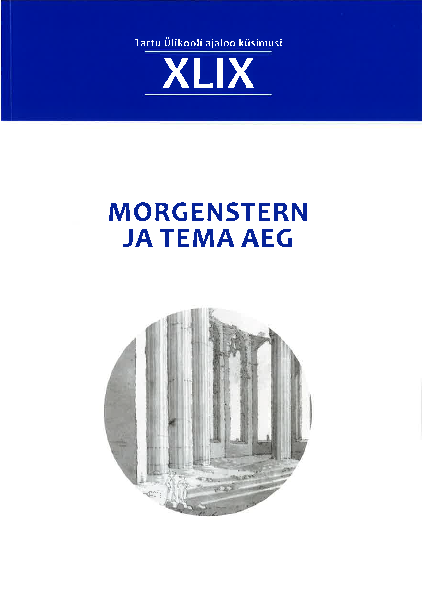Kunst teadmiste süsteemis Karl Morgensterni kunstimuljete näitel
Art as Part of the Knowledge Regime in Karl Morgenstern's Writings
DOI:
https://doi.org/10.15157/tyak.vi49.18377Abstract
Johann Karl Simon Morgenstern (1770–1852) was a Professor of
Aesthetics, Rhetoric, Philology, and Art History at the University of
Tartu/Dorpat. Besides coining the term Bildungsroman, Morgenstern
was also a prolific art historian, creating and spreading knowledge
about art. The reopening of the University of Tartu and Morgenstern’s
deeds are a good example of the change in the knowledge regimes
that occurred around 1800, where art played a crucial role
(P. Burke, Circa 1808: Restructuring Knowledges. München; Berlin:
Deutscher Kunstverlag, 2008, p. 50).
From 1808 to 1810, Morgenstern travelled in Europe and later
published some of his impressions from visiting various art galleries.
In this article I focus on two of his texts: a booklet titled Über einige
Gemälde (Of Some Paintings) from 1805 (K. Morgenstern, Über
einige Gemälde. Dorpat: Universitätsbuchdrucker M. G. Grenzius,
1805), and a text about Raphael’s Transfiguration from 1822 (K. Morgenstern,
Über Rafael Sanzio’s Verklärung.
Dorpat: J. C. Schünmann;
Leipzig: P. G. Kummer, 1822). I will analyse Morgenstern’s views in
the context of Enlightenment ideas on art, and look at the proportion
of knowledge and emotion present in his texts.
Although Morgenstern’s main tool was description, he tried to
provide some analysis as well, taking into consideration composition,
characters, and anatomical correctness, for example. He wrote
both about his contemporary artists and the Renaissance Masters.
Morgenstern’s favourite was apparently Raphael, whom he admired
greatly and to whom he devoted his longest texts. His emotions are
the most unambiguously expressed namely in these writings where
he shows Raphael as a true genius.
It is also interesting how Morgenstern composed his longer texts.
First, he described a picture as if he knew nothing about it. He viewed
the expression of character through certain forms, such as hair or the
folds of clothing. Second, Morgenstern identified and characterised
the figures in a detailed manner. Third, he suggested parts of the picture held deeper symbolic meaning. He tried to show how the details
of a painting contribute to its main emotion and emphasised how
one has to look for and feel the influence of a painting, as it is hard
to describe.
In addition, Morgenstern gave a lot of thought to how his texts
and the artworks (or their reproductions) would reach the audience.
He emphasised the importance of viewing original artwork but worked
diligently to mediate knowledge about it in his lectures at the
university and his writings.

